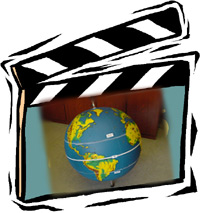 > ENC Master > Climate Encyclopaedia > Weather > basics > 2. Circulation Systems > * Worksheet1
> ENC Master > Climate Encyclopaedia > Weather > basics > 2. Circulation Systems > * Worksheet1
 |
|
|
|
WeatherBasics |
Worksheet: Circulation SystemsSheet 1: Atmospheric Pressure and Hadley Cells
|
hadley cells, image source: NASA, animation by Julia Heres |
|
This figure shows the atmospheric circulation patterns which give rise to the major bands of high and low pressure around the earth. The pressure cells between the equator and 30°N and 30°S are known as Hadley Cells after George Hadley who suggested their existence way back in 1735. These cells transport heat from the equator to the colder temperate and polar regions. Exercise:What´s a Hadley Cell Circulation? Teamwork: (2 or more pupils)Look at the picture of the atmospheric circulation patterns.
|
Explanation:In the tropics there are high temperatures all over the year. Near the equator there is heavy rainfall all over the year, which sometimes is thrice the amount of precipitation that we have in Europe. At the tropics (23,5°) we find less rainfall. In some regions there is no rainfall at all for years. The heavy insolation at the equator is the reason why big amounts of moist and warm air rise. With increasing altitude the air is getting colder again. This causes big towers of clouds and afterwards daily thunderstorms. As the masses of warm air rise there is a low pressure on the ground. This process occurs all around the equator. This is why you find there an area of low pressure – the equatorial low pressure belt. In higher altitudes, the rising air drifts to the North and to the South. And close to the tropics (23,5°) the air falls down to the ground. The air is very dry ,as all the rain has fallen above the equator, and it warms up more and dries out humidity. This warm air falls down, pressing on the air at the ground, and it causes an hot, dry high pressure area. The downswing of the air causes high air pressure on the ground and a zone of dry and very warm air: At the tropics (23,5°) we have high air pressure and at the equator low air pressure. Due to the fact that high air pressure and low air pressure try to balance, the air masses on the ground stream from both sides of the tropics to the equator. These consistent blowing winds are called trade winds. Sailors used them to cross the oceans. As a result of the rotation of the earth, the trade wind of the northern hemisphere drifts to the right and is called north east trade wind. On the southern hemisphere they drift to the left and are called south east trade winds. These warm and dry winds absorb humidity. At the equator they merge and there they close the circle of the trade winds. This whole atmospheric circulation is called Hadley-Cell.
|
Experiment:The winds, coming from the South, drift to the left, those, coming for the North, drift to the right. So it seems as if they come from Northeast or Southeast. Well – you can try to simulate the rotation effect quite simply: |
|
|
What you need: You need a globe (or a big water-melon, a ball or just a tomato).
|
|
Then you should draw the equator and the northern and southern tropics onto the globe. Do you remember the direction the earth rotates? It is anti-clockwise (looking from the north pole). Now you can start to rotate the earth.
|
Movies: Now watch these three movies on the experiment.Attention:
|
|
Movie No.1:If the earth would not rotate, the wind blew straight. |
|
|
|
Movie No. 2:This movie shows the effects of the rotation on the northern hemisphere. The wind does not blow straight but drifts. |
|
|
|
Movie No. 3:This movie shows the effects of the rotation on the southern hemisphere. The wind does not blow straight but drifts. |
|
|
|
Compare your lines on your globe with the films and with the picture. Does it mean that with this wind circulation all sailors meet at the equator? |
|
|
About this page:- Author: - Dr. Schleicher - University of Nürnberg - Germany
|



